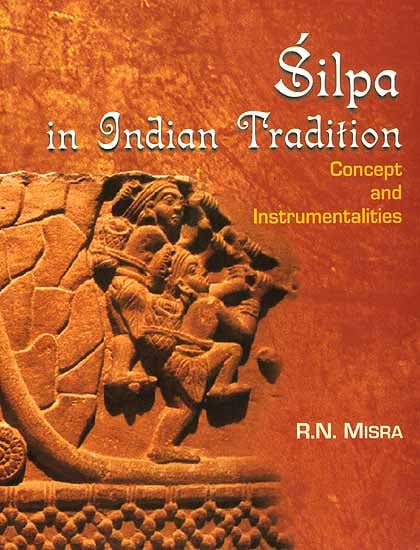
| Specifications |
| Publisher: Aryan Books International | |
| Author: R.N. Misra | |
| Language: English | |
| Pages: 230 | |
| Cover: Hardcover | |
| 9.9" X 7.5" | |
| Weight 670 gm | |
| Edition: 2009 | |
| ISBN: 9788173053542 | |
| IDK924 |
| Delivery and Return Policies |
| Usually ships in 2 days | |
| Returns and Exchanges accepted within 7 days | |
| Free Delivery |
Professor R.N. Misra worked in the Universal of Saugar (1959-76) and Gwalior (1976-2001); he was a Professor in the University of Allahabad (1986-87), and in the Jiwaji University, Gwalior (1980-2001). His last assignment, as a Fellow (2002-2005), was in the Indian Institute of Advanced Study, Shimla.
he is the author of Bharhut (In Hindi), (Bhopal 1971); Ancient Artists and Art Activity (Shimla 1975); Indian Sculpture (In Hindi), (Delhi 1978, Rep. 2002); Yaksha Cult and Iconography (Delhi 1981); Sculptures of Dahala and Daksina Kosala (Delhi 1987); Prachina Bharatiya samaj, arthavyavastha evam dharma (In Hindi), (Bhopal 1991); Adhinayaka mathadhishon ki sanskritik sadhana (Professor R.K. Mukherjee Memorial Lectures), (In Hindi), (Lucknow University 2004). He has also published more than a hundred papers on Indian art, iconography, artists and culture.
It is my pleasant duty to gratefully acknowledge that I owe this work to the encouragement of my guru late Professor V.S. Pathak. In fact, the entire scheme of this monograph took shape in my mind, thanks to the regular discussions I used to have with him, long before I started working in it at that IIAS. The entire project would still have remained dormant but for the opportunity that Professor G.C. Pande so graciously offered to me at the IIAS. Not only that, in the discussions that I could have with him at Shimla, he offered sharply focused insights on the academic content of this work in a manner which only he is uniquely capable of. At the conclusion of this work now, I am happy to be able to express my unmitigated gratitude towards both these scholars, Professor Pande and late Professor Pathak, to whom I dedicate this work.
Pursuing this project at the IIAS was a joy and I should take this opportunity to place on record my sincere gratitude to my friends and well wishers at the IIAS and elsewhere for their support in making this work possible: to the Directors of the IIAS Professor V.C. Shrivastva and Professor (Ms) Bhuvan Chandel who were a constant source of inspiration, always willing to help me out in whatever ways required towards completion of this project; to the current Director of the IIAS, Prof. Peter R. deSouza, who expedited the publication of this work which was submitted in the form of a manuscript as early as September 2005; to Professor Bettina Baumer and Karuna Goswamy for reading the manuscript and offering suggestions; to Navajyoti Singh for his constant interest and critical comments; to Anu Kapoor and her distinguished students for help in finally re-assembling this monograph together after its completion; to the officers and staff of the IIAS, who left nothing to chance in making my family and me comfortable at the Institute in various ways; to Veena, my wife, who was a constant source of confidence to me specially when I started having doubts about competing the manuscript within the scheduled time as other responsibilities at the IIAS, like: arranging and managing a major seminar and editing a bi-annual journal were heaving impinging on my time. I was even toying with the idea of leaving out certain portions that have finally figured in the monograph, but her encouragement and support made me re-work the materials with profit, and do her satisfaction, which is a matter of great joy to me.
Some words about the form and text of his monograph may also be necessary. For diacritical marks on the terms in it from Indian classical language (e.g., Sanskrit and Pali), the Harvard-Kyoto convention has been generally adheres to. Barring exception, no such marks have been used in describing proper nouns representing names of person or places. Index is brief because the contents at the beginning describe the issues that have come up for discussion in the work. The realization about the overuse of Sanskrit terms and phrases in the text came to me too late when there was no time to make amends. I am aware that it might make the reading heavy, but then it, in certain ways, does seem to adhere to the spirit and contents of the subject which may perhaps justify their use.
Finally, I express my sincere thanks to Dr. Debarshi Sen, the Publication Officer and Mr. Ashok Sharma, the PRO at the IIAS, and Mr. Vikas Arya of Arya Books International but for whose active support this work would not have come out the way it finally has.
| Preface | v | |
| List of illustrations | xi | |
| 1. | Silpa | 1 |
| Prologue; Silpa's Rights' of Passage in Tradition; Secular Terrains of Silpa; Rupa-Silpa Interface. | ||
| 2. | Silpin (I) | 44 |
| Anonymity Factor; Artists' Outline in History; The Kokasa Lineage (vamsa) | ||
| 3. | Silpin (II): Silpis' Organisation and Operation | 86 |
| Artists' Organisation: Collectives and Grouping; Silpis at Work; the Patron; Operations; Stores and Supplies; Working Environment; Sutradhara's Role; Work Culture and Discipline; Discipline and Dissent; Modes of Payment; Discharge; Final Dispensations; Concluding Remarks. | ||
| 4. | Sastra | 141 |
| Interactive Domain of Silpasastra in a kindred Group; Constitutive Elements; Representation-centric Conceptualizations; Creative Process: Anusandhana, Anukarana and Anyathakarana; Laksana; Compositional Structure. | ||
| Appendix | 185 | |
| Bibliography | 207 | |
| Index | 215 |
Send as free online greeting card

Visual Search